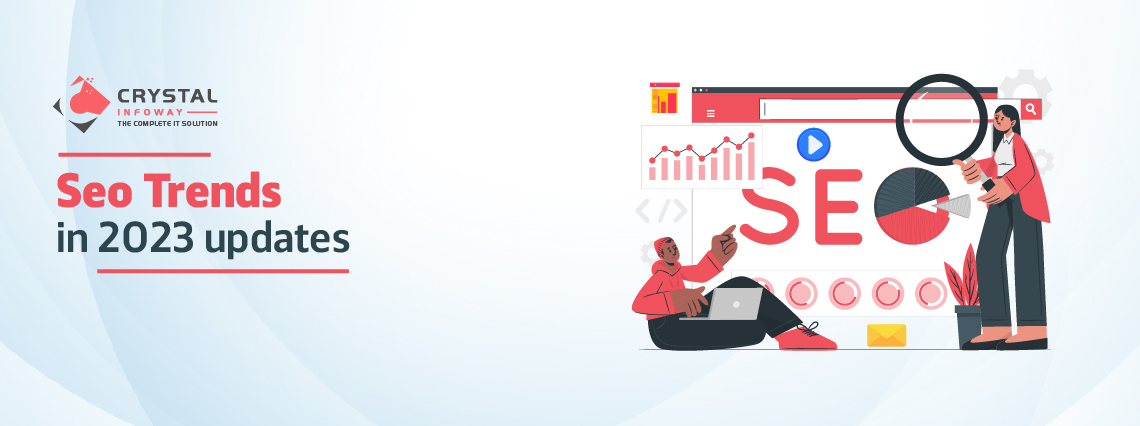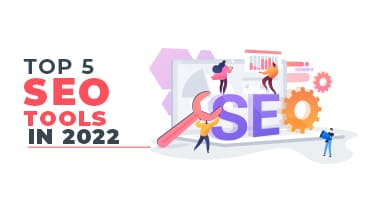
Request a Call Back
Enter your contact details and one of our friendly team member will be in touch soon!.

Enter your contact details and one of our friendly team member will be in touch soon!.

Search engine optimization (SEO) is a set of strategies used by businesses to improve their visibility on the web. By utilizing SEO tactics, companies can ensure that their website and content appear higher in search engine results pages, thus increasing traffic and conversions. As technology advances, so do the trends in SEO. To stay competitive online, businesses need to keep up with the latest developments within the field of digital marketing and adjust their strategy accordingly. Regular updates on SEO trends help companies optimize their websites for maximum performance and remain ahead of the curve when it comes to organic search ranking. With an optimized website, businesses are better equipped to reach customers more quickly and effectively than ever before.
When it comes to content strategy, quality is key. Quality content not only helps search engine optimization (SEO) but also provides an enjoyable user experience. Content should be well-researched and engaging, providing information that readers can use or learn from in some way. Furthermore, including long-form content such as blog posts and articles will help boost SEO rankings by demonstrating expertise and providing more detailed information on a given topic. Longer pieces of content are also more likely to rank higher than shorter ones due to their greater depth of knowledge on the subject matter, so businesses should aim for comprehensive coverage when creating web pages or other written materials. Additionally, they should pay special attention to formatting and ensure that all their text is clear and concise with plenty of subheadings for easy navigation by both users and search engines alike. Finally, using appropriate keywords throughout the piece will help enhance its discoverability online, making it easier for potential customers to find exactly what they’re looking for quickly and easily.
Voice search is a rapidly growing technology that is changing the way consumers interact with websites and mobile apps. With voice search, users can quickly and easily locate information online simply by speaking into their device’s microphone. As such, it’s becoming increasingly important for businesses to optimize their content for voice search to remain competitive in the market.
To get started with optimizing for voice search, companies should first understand how consumers are using this technology and what they expect from it. By researching popular queries related to their industry or products/services, they can gain valuable insight into how people are utilizing these tools and tailor their content accordingly. Additionally, companies should look at existing trends in natural language processing (NLP) as well as machine learning algorithms which allow devices to interpret user requests more accurately—both of which will help them create content better suited for voice searches.
In terms of actual optimization strategies, there are several tactics that businesses can implement when creating content with an eye towards increased discoverability via voice searches: First off, they should focus on long tail keywords rather than short phrases which have become commonplace among written queries; second, they need to ensure accuracy when crafting each piece of text so that both humans and machines can comprehend its meaning; thirdly, using conversational language will make it easier for devices to interpret spoken commands; finally, including structured data such as schema markup not only helps improve ranking but also provides more detailed results when responding to questions posed via voice search platforms like Siri or Alexa.
By leveraging these techniques and staying up-to-date on new developments within the field of SEO best practices specifically tailored towards optimizing for vocal inquiries businesses can ensure that potential customers find exactly what they’re looking for no matter how they choose to access information online.
Mobile optimization is an increasingly important SEO tactic for businesses seeking to remain competitive in the digital marketplace. With more and more individuals using mobile devices to access websites, companies must adapt their content and design accordingly to ensure a seamless user experience across all platforms.
Adopting a mobile-first index is one way of optimizing content for mobile users. This means that when creating webpages or other online materials, businesses should prioritize the mobile version first before considering how the desktop site will look. Doing so ensures that key elements such as text size, navigation menus, and images are optimized for small screens while still delivering a great overall user experience regardless of the device used.
Another way of improving visibility on mobile is through local SEO tactics which focus on targeting particular geographic areas with specialized content tailored towards audiences within those regions. By providing targeted information relevant to each area's unique needs, companies can enhance their presence online by appearing higher up in search results especially when users are searching from specific locations via voice commands or apps like Google Maps or Yelp!
Overall, implementing effective strategies designed specifically with mobility in mind can have major benefits for businesses looking to reach potential customers quickly and efficiently no matter what type of device they’re using at any given time.
Paid Ads are a great way to quickly and efficiently reach potential customers, but optimizing them for maximum performance is key. To ensure the most out of their investment in paid advertising campaigns, businesses should pay special attention to targeting and budgeting. With regards to targeting, companies must identify the exact type of customer they want to reach with their ads and create an audience profile accordingly only showing content relevant to those individuals will help maximize conversions from each ad impression.
Additionally, companies need to establish a clear budget before launching any campaign so as not to overspend or miss out on opportunities due to a lack of funds.
Moreover, by leveraging automation tools like Google Ads or Facebook Ads Manager businesses can streamline the process further by fine-tuning their campaigns based on real-time data collected from users' responses and interactions with their content. This makes it easy for marketers and advertisers alike to modify existing strategies according to such metrics as click-through rates (CTR) or cost per click (CPC) while ensuring they remain within budgetary constraints.
The growing popularity of Pay Per Click (PPC) marketing has also contributed immensely towards enhanced visibility online for many businesses today especially when implemented alongside other digital marketing efforts such as search engine optimization (SEO). PPC allows brands more control over who sees their ads than traditional methods do; plus its measurable nature means that companies can track results much more closely which helps inform future decisions regarding how money is spent on various platforms or types of content. As such, savvy marketers are taking advantage of this powerful tool to reach target audiences more effectively while keeping costs low at the same time.
Schema markup is a powerful tool for businesses looking to increase their visibility online. By adding structured data to web pages, companies can influence how search engines interpret the content and present it in more prominent positions on SERPs (search engine results pages). This type of optimization makes it easier for users to find exactly what they’re looking for quickly and easily while also encouraging higher click-through rates as well as improved overall rankings.
Implementing schema markup correctly requires an understanding of the various types available—from simple “microdata” used to supplement text descriptions up to complex “JSON-LD” which provides detailed information about products or services offered by a company. Fortunately, there are many resources available both online and offline that offer step-by-step instructions for implementing each type of schema properly. Additionally, businesses should be sure to keep track of any changes made via analytics software such as Google Tag Manager so that they can monitor performance closely over time and make adjustments if needed.
In addition to ensuring better discoverability by search engines, using schema markup helps create a richer experience for visitors who come across business websites from organic searches or other sources such as social media platforms like Facebook or Twitter. For instance, certain markups allow developers the opportunity to display reviews directly on their sites instead of relying solely on third-party plugins; similarly, rich snippets provide additional context regarding specific pieces of content further enticing viewers into actually engaging with them rather than just scrolling past without taking notice. Ultimately, this leads not only towards greater engagement but also potentially increased conversions down the line which is something every business strives towards regardless of industry or size!
AI-Powered Optimization is an increasingly popular strategy for businesses looking to stay ahead of the competition and create content that resonates with their target audience. By leveraging this technology, companies can analyze data from past campaigns to gain a better understanding of what type of content works best and what kind of language appeals most effectively to potential customers. This allows marketers to tailor future strategies more precisely while also freeing up time normally spent manually analyzing trends so they can focus on other tasks such as creating new campaigns or expanding into international markets.
Strategies for International SEO are becoming ever more important as companies look to expand their reach beyond local boundaries.
In addition to the usual optimization techniques used at home, those seeking success abroad must adjust tactics to account for different languages, cultural norms, and legal regulations which may vary greatly between regions or countries. For example, when targeting consumers in Asia Pacific companies must use keywords relevant not only within particular nations but also across multiple countries; accordingly, websites should be optimized using language appropriate both linguistically and culturally speaking depending on where they’re being viewed from even if English is generally accepted as the main form of communication online! Furthermore, businesses should ensure compliance with applicable laws regarding advertising practices since failure to do so could lead to hefty fines or even having content removed altogether from certain sites.
By considering these factors when launching any international SEO campaign, brands can ensure maximum effectiveness without sacrificing performance due to localized nuances or regulatory issues related specifically to each market's unique needs–allowing them greater visibility worldwide while remaining compliant with applicable guidelines too!
In conclusion, businesses must continue to stay ahead of the curve when it comes to search engine optimization as trends are constantly changing and evolving. As such, companies need to keep up with the latest developments to remain competitive and ensure that their content is both easily discoverable by users and relevant to current consumer needs. In addition to implementing strategies designed specifically for mobile devices, taking advantage of automation tools like Google Ads or Facebook Ads Manager can help streamline processes further while ensuring maximum performance from each ad impression. Additionally, leveraging schema markup allows brands greater control over how they appear on SERPs while also creating a richer experience for potential customers who come across them organically. Finally, AI-powered optimization provides marketers with invaluable insights into what works best allowing them not only to create more effective campaigns but also free up time so they can focus on other areas such as international SEO which has become increasingly important in today's digital landscape. All told these key trends will play an integral role in determining success online throughout 2023 and beyond!




Introduction Snapchat is a powerful soc...
Read More